100 TRADITIONAL BOBBIN LACE PATTERNS  By the same authors and also published by Batsford: By the same authors and also published by Batsford:
The Book of Bobbin Lace Stitches
Introduction to Bobbin Lace Stitches First published 1982 Reprinted 1986, 1992, 1993, 1997, 2000 Geraldine Stott and Bridget M. Cook 1982 All rights reserved. No part of this publication may be reproduced, stored in a retrieval system, or transmited in any form or by any means, electronic, mechanical, photocopying, recording or otherwise, without the prior written permission of the copyright owner. The lace designs in this book may not be copied or adapted for commercial purposes. eISBN 978-1-849942-36-2 First published as an eBook in 2014 by Batsford 1 Gower Street London WC1E 6HD An imprint of Pavilion Books Company Ltd INTRODUCTION First published 1982 Reprinted 1986, 1992, 1993, 1997, 2000 Geraldine Stott and Bridget M. Cook 1982 All rights reserved. No part of this publication may be reproduced, stored in a retrieval system, or transmited in any form or by any means, electronic, mechanical, photocopying, recording or otherwise, without the prior written permission of the copyright owner. The lace designs in this book may not be copied or adapted for commercial purposes. eISBN 978-1-849942-36-2 First published as an eBook in 2014 by Batsford 1 Gower Street London WC1E 6HD An imprint of Pavilion Books Company Ltd INTRODUCTION  This collection of lace patterns has been carefully selected from various museums, critically analysed and then recreated into workable prickings. Bucks Point is often considered not only to be the Queen of English laces but also, at first glance, to be the most intricate. This collection of lace patterns has been carefully selected from various museums, critically analysed and then recreated into workable prickings. Bucks Point is often considered not only to be the Queen of English laces but also, at first glance, to be the most intricate. This book shows that, with the use of clear diagrams and colour coding for each pattern, even the most complex design will be readily followed. The patterns are arranged progressively, with the first few patterns requiring the use of around 10 to 15 pairs of bobbins, moving through to the widest lace requiring 88 pairs at the end. Conveniently arranged on one page, or adjacent pages, each pattern is set out clearly with the colour coding enabling lace makers to follow easily the design procedure without the usual reference to a lengthily written and highly detailed description of how to proceed from step to step. It is perhaps true to say that few lace makers have the necessary equipment or experience to construct a traditional pricking and to draw out the complex gimp lines from the original lace. In this collection the Authors have completed these stages and have provided clear prickings of each pattern. The prickings can be traced direct from the pattern in the book and pricked in the traditional manner but the Authors would like to suggest that there is an easier, time-saving, method. Photocopiers are now to be found in many offices, libraries and public buildings, and it is recommended that the pricking selected is photocopied. (This is acceptable only on the strict understanding that the photocopy taken is for the personal use of the lace maker.) The photocopied pricking is then covered with a sticky-backed, transparent, coloured book film. (Coloured film is necessary to show up the white threads). In turn this is stuck on pricking card. Some may find that this pricking is too glossy. The sheen can be easily removed with a light rubbing with plain dry wire wool in order to produce a matt finish. The pricking is then pricked and is ready for use. Throughout the book unless otherwise stated the thread used for the pricking was DMC Retors dAlsace No. 60. Gimps were Coats coton broder No. 18. Whilst other threads can be used it will be appreciated that the photographs in this book show the results from the above mentioned threads. Although the illustrated prickings are shown to have a straight edge at the top this has merely been done to provide for the maximum length of pricking to be shown. Normally speaking it is better to start with a diagonal line. Many of the patterns in this book have been adapted to fit modern materials and were extracted from The Lace Dealers Pattern Book in Luton Museum. This book has an interesting history and was donated by Thomas Wyatt Bagshawe and probably belonged to John Spencer, the lace manufacturer from Wellingborough. The book then passed to Lester and Driver, lace dealers in Luton, and then to another lace dealer, Miss F.E. Haines, from whom it was purchased in 1952. The dates of the patterns in the book extend from 1854 to 1893. Interestingly, within all the patterns that have been researched from this book it is clear that there have been no extra pairs of bobbins added into any of the patterns, and the Authors believe that this is typical of the area and period. ACKNOWLEDGEMENTS The Authors wish to express their thanks and appreciation for the co-operation received from the following museums and their staff, without whose assistance the research would have been impossible: Mr H.J. Turner, Bedford Museum, The Embankment, Bedford; Mrs D. Fudge, Museum Division, Wardown Park, Luton, Beds; Miss J. Hodgkinson, The Central Museum and Art Gallery, Guildhall Road, Northampton (Abingdon Museum). The Authors wish to express their thanks and appreciation for the co-operation received from the following museums and their staff, without whose assistance the research would have been impossible: Mr H.J. Turner, Bedford Museum, The Embankment, Bedford; Mrs D. Fudge, Museum Division, Wardown Park, Luton, Beds; Miss J. Hodgkinson, The Central Museum and Art Gallery, Guildhall Road, Northampton (Abingdon Museum). We also wish to thank Mrs E.J. Cummings of Rugby for the use of part of her fine collection. KEY TO DIAGRAMS  | Colour coding |  | Red lines indicate stitches to be worked in whole stitch |  | Blue lines indicate stitches to be worked in half stitch |  | Thin black lines indicate weaving Thick black lines indicate gimp threads |  |  | Little dashes on diagrams show number of twists up to the 20 pair stage then the lacemaker should be advanced enough to determine how many twists are needed |  | Start of a new gimp or gimp pair |  | Finish of a gimp or gimp pair |  | Start of a new pair |  | Taking out of a pair |
 DUTCH DUTCH  | Kleur code |  | Rode lijnen geven linnenslag aan |  | Blauwe lijnen geven netslag aan |  |
| Next page
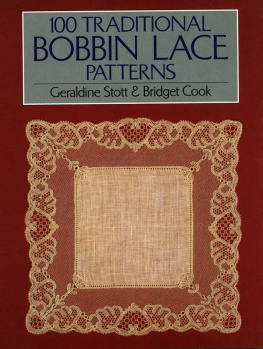
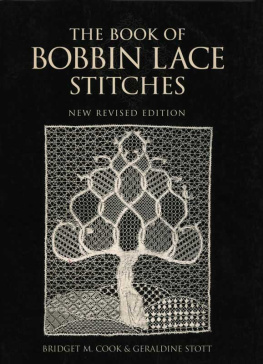
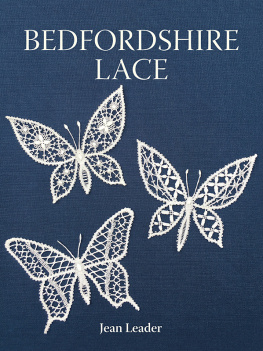
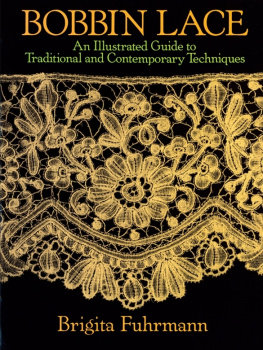

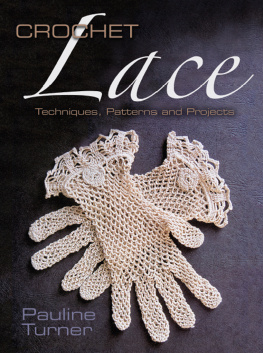
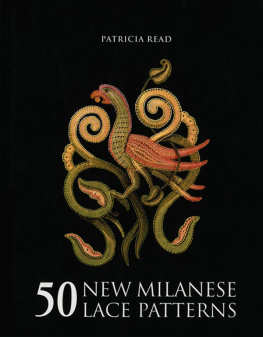
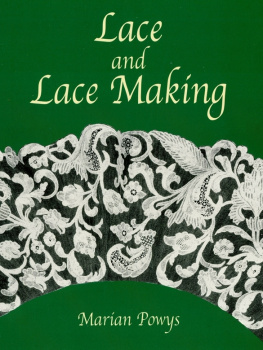
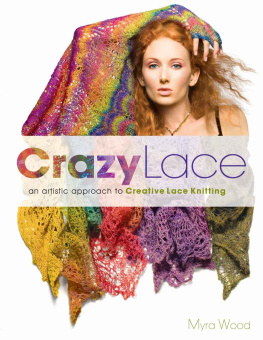

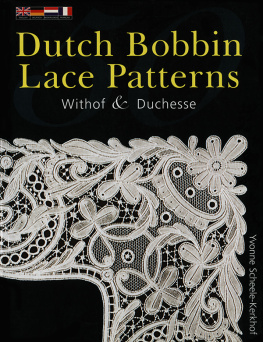
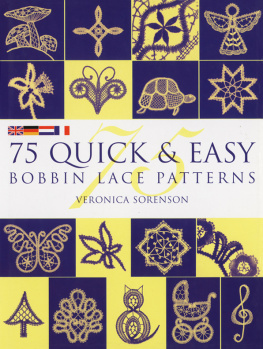
 By the same authors and also published by Batsford:
By the same authors and also published by Batsford: First published 1982 Reprinted 1986, 1992, 1993, 1997, 2000 Geraldine Stott and Bridget M. Cook 1982 All rights reserved. No part of this publication may be reproduced, stored in a retrieval system, or transmited in any form or by any means, electronic, mechanical, photocopying, recording or otherwise, without the prior written permission of the copyright owner. The lace designs in this book may not be copied or adapted for commercial purposes. eISBN 978-1-849942-36-2 First published as an eBook in 2014 by Batsford 1 Gower Street London WC1E 6HD An imprint of Pavilion Books Company Ltd INTRODUCTION
First published 1982 Reprinted 1986, 1992, 1993, 1997, 2000 Geraldine Stott and Bridget M. Cook 1982 All rights reserved. No part of this publication may be reproduced, stored in a retrieval system, or transmited in any form or by any means, electronic, mechanical, photocopying, recording or otherwise, without the prior written permission of the copyright owner. The lace designs in this book may not be copied or adapted for commercial purposes. eISBN 978-1-849942-36-2 First published as an eBook in 2014 by Batsford 1 Gower Street London WC1E 6HD An imprint of Pavilion Books Company Ltd INTRODUCTION 







